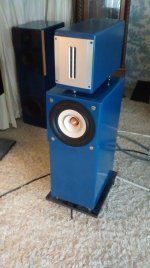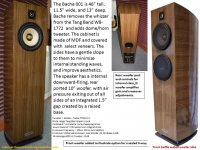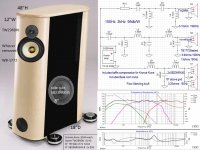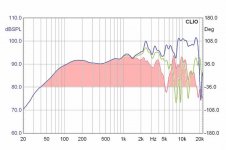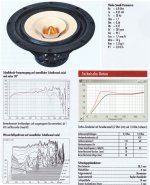Hello everyone!
I've just finished this TB 1808 set up. This is only temporary because I am saving up for the woofers to make my OB.
The TB is just burning in now. I do not have a filter of any kind on it at present. It's a little hot in the top end. I have been reading about a filter in series: 2.5mh and 9ohms. Does that sound about right to you or would you suggest something else?
At present, I have a couple of coil choices. I have a 2.4mh and a 1.5mh... and various resistors. I was going to use the 2.4mh and an 8.2ohm I have on hand, for now.
Thanks.
Shane.
PS: I am using the RT2ii to sweeten the top end a little. 1.5mfd cap, -6db. It's a very subtle add but it's nice.
I've just finished this TB 1808 set up. This is only temporary because I am saving up for the woofers to make my OB.
The TB is just burning in now. I do not have a filter of any kind on it at present. It's a little hot in the top end. I have been reading about a filter in series: 2.5mh and 9ohms. Does that sound about right to you or would you suggest something else?
At present, I have a couple of coil choices. I have a 2.4mh and a 1.5mh... and various resistors. I was going to use the 2.4mh and an 8.2ohm I have on hand, for now.
Thanks.
Shane.
PS: I am using the RT2ii to sweeten the top end a little. 1.5mfd cap, -6db. It's a very subtle add but it's nice.
Attachments
Last edited:
I tried the 2.4mh and 9 ohm for starters. it helped a lot!
I am trying this calculator but it is giving me really screwy numbers. Do you have any suggestions?
https://www.diyaudioandvideo.com/Calculator/SeriesNotchFilter/
I am trying this calculator but it is giving me really screwy numbers. Do you have any suggestions?
https://www.diyaudioandvideo.com/Calculator/SeriesNotchFilter/
That's a very nice looking 'temporary' box.
From this info:
Tabg Band W8-1808 Fullrange Loudspeaker Measurements Data and Information Full Range
...it looks like listening 30 degrees off axis and using the pictured ribbon to fill in the nulls > 6kHz would be the simplest way to eq it.
Yea, this and this:
https://www.minidsp.com/products/acoustic-measurement/umik-1
https://www.minidsp.com/products/minidsp-in-a-box/minidsp-2x4
From this info:
Tabg Band W8-1808 Fullrange Loudspeaker Measurements Data and Information Full Range
...it looks like listening 30 degrees off axis and using the pictured ribbon to fill in the nulls > 6kHz would be the simplest way to eq it.
I am trying this calculator but it is giving me really screwy numbers. Do you have any suggestions?
Yea, this and this:
https://www.minidsp.com/products/acoustic-measurement/umik-1
https://www.minidsp.com/products/minidsp-in-a-box/minidsp-2x4
You could Sweeney Todd the whizzer... not Harry Potter.... the whizzer cone.
Bache is one speaker designer who removes the whizzer cone from the TB W8-1772, and then uses the driver in an "extended range" 3-way with a Fostex horn loaded tweeter.
Your W8-1808 with a dome or ribbon tweeter would be interesting to model.
Bache is one speaker designer who removes the whizzer cone from the TB W8-1772, and then uses the driver in an "extended range" 3-way with a Fostex horn loaded tweeter.
Your W8-1808 with a dome or ribbon tweeter would be interesting to model.
Attachments
ShaneF, I am following your progress on this. I have the 1808 and like it just fine but it becomes fatiguing. This is what you are trying to fix. My attempts to listen off axis help for a little while. This driver has amazing detail and resolving abilities. I hope your project is a success!
The frequency response printed on the TB site is smoothed a bit too much, but at least shows a rising response by 10dB from 500 - 10kHz. That's something ALL big fullrange drivers employ, but because of the directivity the treble will fall off quite gently when the speakers are angled in just a bit. The Tangband were measured very precisely in the german 'HobbyHifi' with a similar response but a more prominent peak around 3 KHz.
The problem area is in fact 2-5kHz that will remain even at 30° and has to be tamed down, as "Mr. Psycho" (sorry Norman, couldn't resist) already pointed out.
You built a nice case Shane but it is rather small (width) so will not support the lower part of the frequency response very much, rather in the lower midrange. That is where your notch of 2.4mH and 9R helps, but I would also try different values for the coil (smaller values will shift the notch higher up) and see what you like better.
Generally I don't like the idea of removing the whizzer cone... you either live with the chassis as fullrange or you get a different one. It will definitely benefit from a nice woofer down low..
The problem area is in fact 2-5kHz that will remain even at 30° and has to be tamed down, as "Mr. Psycho" (sorry Norman, couldn't resist) already pointed out.
You built a nice case Shane but it is rather small (width) so will not support the lower part of the frequency response very much, rather in the lower midrange. That is where your notch of 2.4mH and 9R helps, but I would also try different values for the coil (smaller values will shift the notch higher up) and see what you like better.
Generally I don't like the idea of removing the whizzer cone... you either live with the chassis as fullrange or you get a different one. It will definitely benefit from a nice woofer down low..
Lol, yup.
Removing the wiz won't help the 1.25khz to 3.5khz.
That is the cone.
If you remove the whizzer, i bet a paycheck that the response would climb more and keep climbing to maybe 7khz then drop off a cliff.
Ask for help in a new thread for w8 1808 plus notch, maybe i can approximate some values.
Mother is calling...............
Removing the wiz won't help the 1.25khz to 3.5khz.
That is the cone.
If you remove the whizzer, i bet a paycheck that the response would climb more and keep climbing to maybe 7khz then drop off a cliff.
Ask for help in a new thread for w8 1808 plus notch, maybe i can approximate some values.
Mother is calling...............
The problem area is in fact 2-5kHz that will remain even at 30° and has to be tamed down, as "Mr. Psycho" (sorry Norman, couldn't resist) already pointed out.
Rutcho's site shows it as very flat to 5.5kHz at 30 degrees off axis (the green line).
The anomalies are:
a) The big lump 600-1kHz. This seems to be a cabinet and/or measurement artifact - it shows up on lots of Rutcho's sealed box plots.
b) That "prominent peak around 3 KHz" which seems like a driver problem. If it were my project, I'd try to fix this with a physical modification, or with a DSP.
Tabg Band W8-1808 Fullrange Loudspeaker Measurements Data and Information Full Range
If you remove the whizzer, i bet a paycheck that the response would climb more and keep climbing to maybe 7khz then drop off a cliff.
That's roughly what happened with this driver:
Wharfedale Super 8
...but the Tang Band might fare a little better, as it has a curved cone.
The anomalies are:
a) The big lump 600-1kHz. This seems to be a cabinet and/or measurement artifact - it shows up on lots of Rutcho's sealed box plots.
b) That "prominent peak around 3 KHz" which seems like a driver problem. If it were my project, I'd try to fix this with a physical modification, or with a DSP.
The big lump is very likely the baffle step... the chassis was measured in a cabinet of maybe 30cm width.
Measurements of Tangband and HobbyHifi are taken on an infinite wall (the editor of HH has provisions to mount the chassis into the floor of his measurement room and has the mic pointing down.) You also see that the bass response has fallen off by roughly 6dB --> baffle step.
That is probably quite accurate / pretty close to what the OP is using.The big lump is very likely the baffle step... the chassis was measured in a cabinet of maybe 30cm width.
I found a German chart here - not sure if it is the same one. It seems consistent with an infinite wall and less resolution / more smoothing.Measurements of Tangband and HobbyHifi are taken on an infinite wall (the editor of HH has provisions to mount the chassis into the floor of his measurement room and has the mic pointing down.)
This graph seems to confirm that there is a listening angle for which the range up to 5kHz is pretty flat.
https://www.oaudio.de/en/Loudspeake...nge-drivers/Wide-range-Tang-Band-W8-1808.html
You also see that the bass response has fallen off by roughly 6dB --> baffle step.
I might see it, if I knew which graph you meant. Can you post an image? 🙂
The on-axis plots that I can see have lots of ragged HF rise, and would need a lot of magic to 'fix'.
For the off-axis graph that I have attached and highlighted, assuming the OP uses his ribbon tweeter to fill in the nulls, it would fit within a 4dB window.
The listener would have to be in the right spot, but that's how it is with most ribbons and with 8" wide-band drivers.
Attachments
Thanks hollowboy for your reply.
No, it's yet another one. The graphs out of HobbyHifi are not published, maybe I can scan and post it here in the evening. The curves in HH are taken with MLSSA and very accurate, I cannot tell how the graph on the website you linked was taken (cabinet of some size?).
When it was me I wouldn't be too concerned about the ragged HF response above 5kHz and just tame down the midrange peak with a notch or shelving filter (I think the filter mentioned above is in fact a shelving filter... coil and resistor in // ) at around 15 degrees toe in of the cabinets. No additional tweeter then, or just really high to add some ambience.
I found a German chart here - not sure if it is the same one.
No, it's yet another one. The graphs out of HobbyHifi are not published, maybe I can scan and post it here in the evening. The curves in HH are taken with MLSSA and very accurate, I cannot tell how the graph on the website you linked was taken (cabinet of some size?).
True, but is then followed by a big dip that would require a tweeter. And it looks that you would have to angle the cabinets at least 30 degrees which is considerable. 😉This graph seems to confirm that there is a listening angle for which the range up to 5kHz is pretty flat.
I was referring to the graph on the Rutcho site, but the response could also be due to the measuring window chosen... so not too accurate. And the OP is planning to support the lows with those nice PD devices anyway. 🙂I might see it, if I knew which graph you meant. Can you post an image?
When it was me I wouldn't be too concerned about the ragged HF response above 5kHz and just tame down the midrange peak with a notch or shelving filter (I think the filter mentioned above is in fact a shelving filter... coil and resistor in // ) at around 15 degrees toe in of the cabinets. No additional tweeter then, or just really high to add some ambience.
Have any of you had experience with the PD 186.2? It's a pricey driver. It certainly looks good and comes highly recommended. I have looked at other drivers and the ones that frequently popped up are cheap stamped frames. That's not turning me on too much. The eminence drivers seems to come up in conversation quite often. I would prefer not to go with 2 X 15" drivers. A good, single 15 or 18 would make me happy, in tandem with the planar tweet I have now.
Here's the measurement of the Tangband W8-1808 out of HobbyHifi.
The reddish curve shows the approximate effect of the baffle step (added by me).
Still quite similar to the other's and actually pretty good for such a big fullrange.
Best is there are no major dips that are hard to equalize with a passive filter.
The reddish curve shows the approximate effect of the baffle step (added by me).
Still quite similar to the other's and actually pretty good for such a big fullrange.
Best is there are no major dips that are hard to equalize with a passive filter.
Attachments
I've had the other cousin , the 1772, for a while.
If only a BSC is applied, it makes for its own characteristics, maybe the 5k peak makes it sound more "detailed" to some ears, and that's why it gets good reviews.
But, I can confirm that this driver will sing, and sound wonderfully balanced and detailed when using DSP. I know it's not a route some would follow, but with this driver, DSP unlocks its wonderful potential.
If only a BSC is applied, it makes for its own characteristics, maybe the 5k peak makes it sound more "detailed" to some ears, and that's why it gets good reviews.
But, I can confirm that this driver will sing, and sound wonderfully balanced and detailed when using DSP. I know it's not a route some would follow, but with this driver, DSP unlocks its wonderful potential.
It sure looks like one hefty unit. No experience with them whatsoever, but they seem very well made and have interesting specs. Very low losses but high-ish Qts. Do want to run them as open baffle since even a closed enclosure would have to be really big...😱 Are you planning to run it as active sub which would make sense to find the right crossover to the Tangband's?Have any of you had experience with the PD 186.2? It's a pricey driver.
The only comparable driver I had was an Eminence Kilomax 18 that I planned to use in a big dipole subwoofer. Never came around to actually build it, sold the chassis last year.
- Status
- Not open for further replies.
- Home
- Loudspeakers
- Full Range
- TB W8-1808 filter?
